Cathinones are a loosely defined group of central nervous system stimulants that tend to increase alertness and cause agitation or excitation (NCBI, 2015). Common neurologic effects of cathinone use include anorexia, headache, hyperactivity, insomnia, and tremors as well as depression, panic attacks, and anxiety. Chronic use may result in paranoid psychosis. Cathinones may be addictive.


Left: Catha edulis, a flowering plant native to the Horn of Africa and the Arabian Peninsula. Source: Wikipedia, public domain. Right: Bundles of khat. Source: Drug Enforcement Administration.
Synthetic cathinones, also referred to as bath salts, are artificially engineered drugs belonging to the phenethylamine* class. They are similar to amphetamine, ecstasy (MDMA), and cathinone structurally and pharmacologically, and all drugs in this category share certain structural similarities. Synthetic cathinone products are also marketed as plant food, fertilizer, insect repellant, pond-cleaner, and vacuum fresheners (Karch, 2015).
*Phenethylamine: a class of organic alkaloid chemicals known for their psychoactive and stimulant effects. Similar to amphetamine in its action at common biomolecular targets, releases norepinephrine and dopamine.
Many of the most common designer stimulants are derivatives of cathinone, the primary active alkaloid in the natural herbal stimulant khat (Catha edulis) (Weaver et al., 2015). Khat (pronounced “cot”) has been utilized for centuries by indigenous peoples of the Horn of Africa and Arabian Peninsula for its stimulant properties (Watterson & Olive, 2014).
Synthetic Cathinones Are Chemically Related to MDMA (Ecstasy)
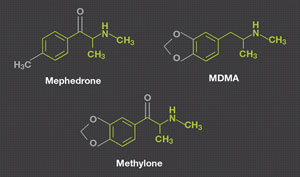
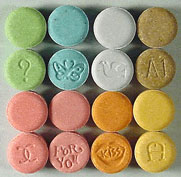
Left: Mephedrone, methylone, and MDMA (ecstasy) all share the chemical structures shown in green. Source: NIDA, 2013. Right: Ecstasy tablets, which allegedly contain MDMA, but may contain adulterants. Source: Wikipedia.
Synthetic cathinones did not appear on the United States’ illicit drug market until 2010, but they have been popular drugs of abuse in Europe since 2003 (Karch, 2015). The rise of synthetic cathinone use in the United States was alarmingly rapid, with poison control centers receiving 0, 304, and 6,156 reports of synthetic cathinone toxicity in the years 2009 to 2011, respectively (Watterson & Olive, 2014).
Synthetic Cathinones (Bath Salts) Drug Facts | |
|---|---|
Street names | Blizzard, Bloom, Blue Bliss, Charge+, Cloud Nine, Cosmic Blast, Drone, Energy-1, Hurricane Charlie, Ivory Snow, Ivory Wave, Lunar Wave, Meow Meow, Ocean Burst, Pure Ivory, Purple Wave, Red Dove, Scarface, Silk, Snow Leopard, Stardust, Vanilla Sky, White Dove, White Knight, White Lightning, White Rush |
Commercial names | No commercial uses for ingested “bath salts” |
Common forms | White or brown crystalline powder sold in small plastic or foil packages labeled “not for human consumption” and sometimes sold as jewelry cleaner; tablet, capsule, liquid |
Common ways taken | Swallowed, snorted, injected |
DEA schedule | Schedule I, some formulations have been banned by the DEA |
Cathinone Pharmacology
Synthetic cathinones (also referred to as “designer substituted cathinones”) are part of the larger family of stimulants that includes amphetamine, methamphetamine, and MDMA (ecstasy) (Weaver et al., 2015). They work by stimulating release and inhibiting the re-uptake of norepinephrine, serotonin, and dopamine (Falgiani et al., 2012).
Synthetic cathinones are rapidly absorbed: the “high” is at its most intense 1.5 hours after oral consumption and lasts for 2 to 8 hours, depending on the substance (Hohmann et al., 2014). The pharmacology and product effects (such as increased alertness, tachycardia, and potential for psychosis) appear similar to stimulants such as amphetamines and cocaine (Weaver et al., 2015).
All drugs in this category share certain common structural similarities and yield a group of substances with cathinone as their core structure. Certain synthetic cathinones—methedrone, mephedrone, methylone, and MDVP—seem to be particularly widespread and problematic (Karch, 2015).
Methedrone, Mephedrone, Methylone, and MDPV
Methedrone, mephedrone, methylone, and MDVP are the most likely active agents found in most bath salts. Of these, mephedrone appears to be the most common synthetic cathinone sold on the recreational market (EMCDDA, 2015).
Methedrone, Mephedrone, Methylone, and MDPV
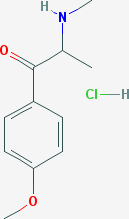
Methedrone

Mephedrone
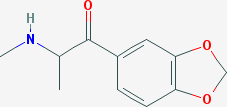
Methylone
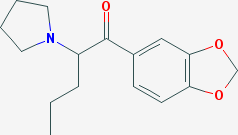
MDPV
Note the similar chemical structure of these four synthetic cathinones. Making a small chemical change alters the effects of the drug and creates a slightly different nervous system response. Source: PubChem, 2015.
Methedrone
Methedrone (meth-a-drone) is a synthetic cathinone first synthesized in 1933. Due to the ease with which synthetic cathinones can be chemically modified to create unique chemical entities, more than forty synthetic cathinones have been identified in clandestine drug markets, including “second generation” synthetic cathinones such as methedrone (Watterson & Olive, 2014).
Methedrone is closely related to methylone and mephedrone and has euphoric and stimulant properties. Very little research has been conducted on methedrone and little is known about its pharmacodynamics. Doses are reported by users to vary from 50 to 500 mg, with its effects lasting from 45 minutes to 2 hours. Methedrone should not be confused with methadone.
Mephedrone
Mephedrone (mef-a-drone) is a synthetic central nervous system stimulant that, in very small amounts, can produce psychoactive symptoms such as intense pleasure, feelings of happiness, light-headedness, a distorted sense of time, and reduced appetite, as well as paranoia, increased blood pressure, anxiety, nausea, vomiting, and convulsions. Overdose can lead to seizures, respiratory failure, and death. Based on its chemical structure, mephedrone likely works by blocking re-uptake of, and stimulating the release of, stimulant neurotransmitters such as serotonin, dopamine, and norepinephrine (NCBI, 2015).
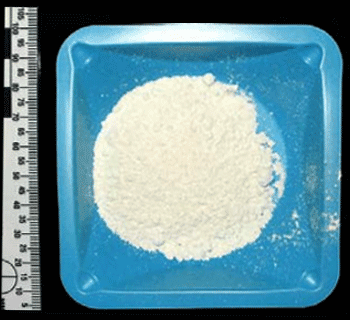
A sample of mephedrone that was confiscated in Oregon, 2009. Source: Drug Enforcement Administration.
Mephedrone was initially synthesized in 1928 but did not become a recreational drug until 2003. It first gained notoriety in Europe, especially in the United Kingdom, because of the remarkably high incidence of hospital admissions, even deaths, associated with its use. The European Monitoring Centre for Drugs and Drug Addiction (EMCDDA) reported that during the first quarter of 2010, mephedrone was detected in about twenty European Union Member States (Karch, 2015).
The main routes of administration for mephedrone are snorting (nasal insufflation) and swallowing (oral ingestion), sometimes after dissolving with water. As mephedrone is primarily available in powder form, injecting use is reported but appears to be rare (NCBI, 2015).
Symptoms reported anecdotally by users of mephedrone include: numbness and lack of tactile sensitivity, loss of appetite, insomnia, increased mean body temperature (“mephedrone sweat”), decreased mean body temperature, bruxism, elevated heart rate and blood pressure, chest pain, nausea and vomiting, painful joints, discoloration of extremities and joints, abdominal pain, painful nasal drip with presence of blood, light-headedness and dizziness, tremors and convulsions, headaches, cravings, nightmares, loss of concentration and memory loss, anxiety, dysphoria, depression, hallucinations, paranoia, fatigue, and respiratory difficulties (NCBI, 2015).
Thirty-One Cases
Detailed data on 31 cases of acute toxicity associated with self-reported mephedrone use in London since January 2009 indicated the most common clinical symptoms/signs on presentation were:
- Agitation (51.6%)
- Palpitations (25.8%)
- Vomiting (19.4%)
- Self-limiting pre-hospital seizure (9%)
- Bruxism (3.4%)
- Headache (3.4%)
No patients had any skin discoloration or cool/cold peripheries. Twenty-five (80.6 %) patients were discharged either directly from the emergency department or the short-stay observation ward. These patients required either a period of observation prior to discharge and/or symptom control medications.
Four (12.9 %) patients required the use of benzodiazepines for the management of agitation on presentation to the hospital. Of the six patients who were admitted to hospital, four were admitted for observation and management on a general internal medicine ward and two (6.4% of all presentations) required admission to the intensive care unit. All patients survived to leave hospital with no long-term sequelae on discharge.
Source: NCBI, 2015
Methylone
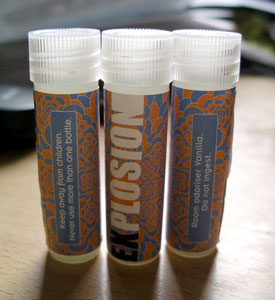
Three containers of a liquid called “Explosion” sold in The Netherlands in 2004. Analysis identified the liquid to be methylone. Printing on the label reads “Room odorizer Vanilla. Do not ingest. Keep away from children. Never use more than one bottle.” Source: Wikipedia, GNU Free Documentation License.
Methylone (meth-a-lone) is an analogue of MDMA (ecstasy). It first appeared in The Netherlands, mixed with mCCP (meta-chlorophenylpiperazine) as the main component of a designer drug called “Explosion.” According to United Nations drug monitors, Methylenedioxypyrovalerone (MDPV) and methylone are among the most popular synthetic cathinones. MDMA and mCCP are both semi-synthetic derivatives methcathinone (Karch, 2015).
Very little is known about methylone pharmacokinetics but there are unsettling reports that when methylone is co-ingested with MDVP, bizarre behavior, including a number of suicides, deaths, highly violent crimes, and delirium have occurred. The pathophysiology of methylone-related deaths is also poorly understood, but some in vitro evidence is emerging, the results of which seem to explain the myriad of symptoms observed. Symptoms seem to fall on a scale somewhere between serotonin syndrome* and excited delirium. The greater the methylone concentration, the greater the agitation produced. Both the psychological and physiologic abnormalities appear to be dose-related (Karch, 2015).
*Serotonin syndrome: occurs when two drugs that affect the body’s level of serotonin are taken at the same time. The drugs cause too much serotonin to be released or to remain in the brain area. Serotonin syndrome is more likely to occur when you first start or increase a drug.
Self-Reported Side Effects of Methylone (NCBI, 2015) | |
|---|---|
Modest to moderate severity | Most severe |
Increase in heart rate and blood pressure | Insomnia |
General change in consciousness (as with most psychoactives) | Hyperthermia and sweating |
Pupil dilation, can lead to blurred vision | Dizziness, confusion |
Difficulty in focusing, restlessness | Depersonalization, hallucinations, paranoia, fear (with high doses) |
Change in perception of time | Unwanted life-changing spiritual experiences |
Slight increase in body temperature | Gastrointestinal discomfort, nausea and vomiting |
Muscle tension and aching | Skin rashes common |
Trismus and bruxism | Hangover may include exhaustion, depression, disorientation, headache, amnesia. |
Case
A 22-year-old woman was brought to the emergency department following several episodes of tonicoclonic seizures a few hours after ingesting “legal ecstasy.” The patient needed intubation for recurrent seizures and she was found to have severe hyponatremia (120 mmol/L) that was corrected with hypertonic saline. The patient’s mental status improved rapidly, and she was extubated the day following her admission. However, she developed prolonged rhabdomyolysis (CK 34.537 U/L) that required a 6-day hospitalization.
The seizures and the hyponatremia may be explained by the MDMA-like characteristics of methylone that may induce inappropriate secretion of antidiuretic hormone mediated via the serotonin system. The combination of methylone and ethcatinone (both acting like serotonin re-uptake inhibitors) might have contributed to neurologic manifestations compatible with serotonin toxicity, although the patient never had autonomic instability. The patient had a prolonged period of rhabdomyolysis which may also be explained by excessive serotonin activity resulting in an increased motor hyperactivity.
Source: NCBI, 2015.
Mephedrone and Methylone Increase Extracellular Serotonin and Dopamine
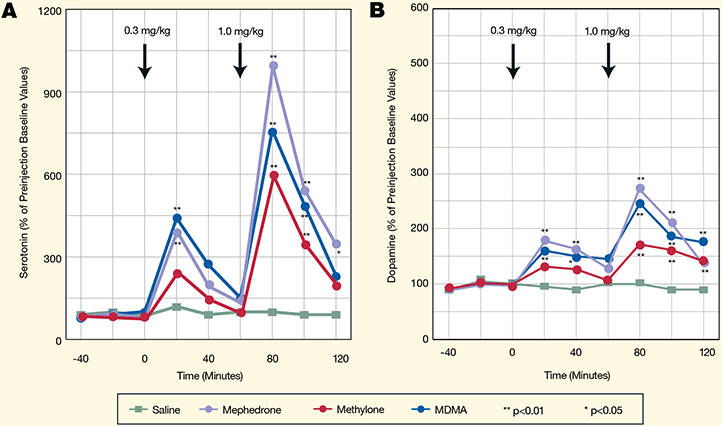
Direct measurements of neurochemical release in the nucleus accumbens of living rats show that the higher the dose of mephedrone and methylone, the greater the increase in extracellular dopamine and serotonin levels. Like MDMA, the drugs produce a greater effect on serotonin (Figure 1A) than on dopamine (Figure 1B). Asterisks indicate a significant difference compared to saline-injected controls at a particular time point. Source: NIDA Notes, 2013.
MDPV: Methylenedioxypyrovalerone
Methylenedioxypyrovalerone (MDPV) is a derivative of pyrovalerone, which is a psychoactive drug that in the past was used to treat chronic lethargy and fatigue (Karch, 2015). As such, MDPV is one of many “failed” pharmaceuticals (substances originally developed as potential therapeutic agents, but never brought to market as licensed medicines). An important feature of the designer drug phenomenon has been the re-discovery of these agents as a potential source for commercial distribution on the illicit drug market (Brandt et al., 2014).
MDPV differs from other synthetic cathinones because it contains a pyrrolidine ring, which makes the drug a potent uptake blocker at dopamine and norepinephrine transporters, in much the same fashion as methylone. Although MDPV, mephedrone, and methylone are now controlled drugs, a group of MDPV derivatives remains legal (Karch, 2015).
The most frequently encountered MDVP derivatives are referred to as pyrrolidinophenones. Alpha-pyrrolidinovalerophenone (alpha-PVP) is the one most frequently encountered. In rats, alpha-PVP acts as a potent uptake blocker of dopamine and norepinephrine transporters, comparable in activity to MDPV; it is also a catecholamine* transporter blocker. This property may explain the hyperactivity that MDPV seems to induce. It may also explain why MDPV, and all of its analogs, induce stimulant effects at lower doses but bizarre behaviors at higher doses (Karch, 2015).
*Catecholamine: epinephrine (adrenaline), norepinephrine (noradrenaline) and dopamine; all of which are produced from phenylalanine and tyrosine. Release of the hormones epinephrine and norepinephrine from the adrenal medulla of the adrenal glands is part of the fight-or-flight response.
The acute side effects of MDPV include tachycardia, hypertension, vasoconstriction, and sweating. The duration of the subjective effects is about 3 to 4 hours and the side effects continue for a total of 6 to 8 hours after administration. Higher doses of MDPV have caused intense prolonged panic attacks in stimulant-intolerant users. Users have reported bouts of psychosis induced by sleep deprivation and becoming addicted after using higher doses or using at more frequent dosing intervals (NCBI, 2015).
Alpha-PVP is chemically similar to other synthetic cathinone drugs and takes the form of a white or pink foul-smelling crystal that can be eaten, snorted, injected, or vaporized in an e-cigarette or similar device. Vaporizing, which sends the drug very quickly into the bloodstream, may make it particularly easy to overdose. Like other drugs of this type, alpha-PVP can cause a condition called “excited delirium” that involves hyperstimulation, paranoia, and hallucinations that can lead to violent aggression and self-injury. The drug has been linked to deaths by suicide as well as heart attack. It can also dangerously raise body temperature and lead to kidney damage or kidney failure. A synthetic cathinone closely related to MDVP called alpha-pyrrolidinopentiophenone (alpha-PDP)—popularly known as “Flakka”—is surging in Florida and is also being reported in other parts of the country (NIDA, 2015c).
Acute Effects of Cathinone Use
Most designer stimulants are taken intranasally and the effects generally start about 10 to 20 minutes after dosing, peak at 45 to 90 minutes, last 2 to 3 hours, and then decrease over 6 to 12 hours. Users may consume multiple doses during a session to prolong the desired effects. Commonly reported effects—similar to cocaine, amphetamine, and MDMA—include increased energy, alertness, concentration, sexual stimulation, empathy, talkativeness, mood enhancement, euphoria, and decreased appetite (Weaver et al., 2015).
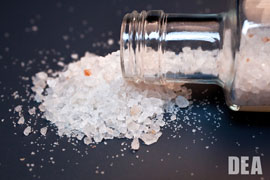
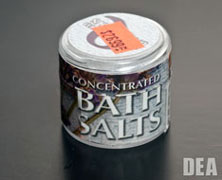
Confusing and misleading labeling add to the abuse of bath salts. Source: Drug Enforcement Administration.
Most synthetic cathinone users report intermittent adverse effects. Acute toxicity may be associated with larger binge consumption and exposure to multiple substances. Acute agitation is a hallmark of toxicity. Psychosis may be pronounced, with patients experiencing paranoia, hallucinations (primarily visual), and delusions (Weaver et al., 2015).
Repeated use of synthetic cathinones will likely lead to tolerance, which is indicated indirectly by the association between frequency of use and greater amount consumed. Binges have been reported with significant successive dosing of mephedrone. Withdrawal effects reported among chronic users include tiredness, insomnia, difficulty concentrating, irritability, depression, and nasal congestion. Some users experience a dependence syndrome with cravings and compulsive use (Weaver et al., 2015).
Sympathomimetic* toxicity is manifested by neurologic and cardiovascular clinical features. The use of bath salts has been associated with cardiac arrhythmias and myocarditis. Significant hyponatremia has been reported with mephedrone use (similar to that seen with MDMA), which is likely due to a combination of sweating, electrolyte loss, and antidiuretic hormone secretion. More serious renal impairment includes acidosis and acute renal failure associated with rhabdomyolysis. Deaths have been reported with mephedrone and MDPV (Weaver et al., 2015).
*Sympathomimetic: stimulant compounds that mimic the effects of agonists of the sympathetic nervous system such as the catecholamines (epinephrine, norepinephrine, dopamine, etc). Sympathomimetic drugs are used to treat cardiac arrest and low blood pressure, or even delay premature labor, among other things.
Bath salts were largely responsible for a doubling in annual stimulant or sympathomimetic-related toxicology cases reported, from 6% in 2010 to 12% in 2011. Commonly reported effects include diaphoresis, palpitations, muscle tension or spasms, and bruxism (jaw clenching). Most individuals exhibit autonomic hyperactivity on exam (eg, tachycardia, hypertension). Nasal-specific adverse effects include epistaxis and sore nasal passages, mouth, and throat (Weaver et al., 2015).
In addition to the cathinone effects, contaminants can play a role in adverse effects. Product analysis studies have found adulteration with benzocaine, lidocaine, procaine, caffeine, or even controlled drugs such as cocaine, amphetamine, ketamine, and piperazine compounds. Adulterants with stimulant properties could potentiate* the effects of bath salts and raise toxicity risk by increasing the sympathetic effects or chances of cardiac arrhythmias (Weaver et al., 2015).
*Potentiate: to intensify or increase the power or effect of a drug and increase the likelihood of a physiologic reaction.
Empirical or prospective data are limited regarding long-term adverse physiologic effects of synthetic cathinone use. However, neurotoxicity is plausible (eg, monoamine depletion, neuronal degradation) along with development of physiologic dependence among regular users, which is manifested by tolerance and a withdrawal syndrome (Weaver et al., 2015).
Bath Salts vs. Epsom Salts
The synthetic cathinone products marketed as “bath salts” to evade detection by authorities should not be confused with products such as Epsom salts that are sold for soaking and bathing. The latter have no psychoactive (drug-like) properties.
Source: National Institute on Drug Abuse.
